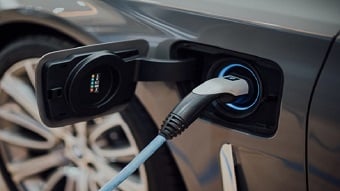What are compressed air cars?
Ryan Clancy | October 30, 2023Pneumatic cars, or compressed air cars, are a revolutionary alternative to traditional gasoline or diesel vehicles. Instead of relying solely on fossil fuels, these innovative cars harness the power of compressed air in conjunction with a small amount of fuel to propel their engines. This unique combination not only offers an eco-friendlier transportation option but also signifies a significant step toward a greener future.
Working principle of compressed air cars
Compressed air cars utilize a technology rooted in the principles of pneumatics, leveraging compressed gases to generate mechanical motion. By harnessing the force of compressed air, these vehicles provide a sustainable alternative to conventional cars.
 This is what a compressed air/pneumatic motor setup usually looks like. Source: Studio Harmony/Adobe Stock
This is what a compressed air/pneumatic motor setup usually looks like. Source: Studio Harmony/Adobe Stock
How it works
The working principle of a compressed air car is quite simple yet effective. The vehicle uses a compressed air engine instead of an internal combustion engine, which is commonly used in conventional cars.
When the driver presses the accelerator pedal, compressed air is released from a storage tank and enters the engine through a valve system. Inside the engine, the air expands and pushes against pistons that power the car's motion. This expansion of air is similar to the way gasoline expands inside an engine, but without the harmful emissions.
To keep the car running continuously, a small amount of fuel is used to heat up the compressed air before it enters the engine. This process is known as thermodynamics and helps in maintaining a constant pressure within the engine for optimal performance.
Compressed air cars started with compressed air bicycles
Compressed air cars may seem like a fairly new concept, but it all started with compressed air bicycles. These bikes have been around for decades and were popular projects among hobbyists and inventors. In fact, the first recorded instance of a compressed air bicycle was back in 1828, when an English inventor created one from two storage tanks.
It wasn't until the 1970s that engineers and researchers started seriously considering compressed air as a potential fuel source for cars.
The birth of compressed air bicycles
As mentioned earlier, the concept of compressed air bicycles can be traced back to 1828. But it wasn't until the late 20th century that they gained popularity as projects for university students and DIY enthusiasts. These bikes were seen as a fun and innovative way to explore the possibilities of alternative energy sources.
One of the main reasons why compressed air bicycles became popular was their simplicity. Unlike traditional bikes that require fuel or electricity, these bikes simply used compressed air to power them. This made them environmentally friendly and accessible for anyone to build.
However, there are no compressed air bikes that can be bought at the moment, primarily due to their limited range. A compressed air bicycle built by a YouTuber could only travel about 3/8 of a mile before needing to be refilled.
Advantages of compressed air cars
Let’s go through the various (hypothetical at this stage) advantages of compressed air cars.
No bio-carbon-based fuel
One major benefit of compressed air cars is their independence from bio-carbon based fuels. Unlike conventional vehicles that rely on fossil fuels, emitting harmful gases like carbon dioxide and contributing to air pollution, compressed air cars utilize clean and non-toxic compressed air, producing zero emissions. This makes them an environmentally sustainable and eco-friendly transportation option.
Size reduction
Compressed air cars are significantly smaller in size compared to traditional vehicles. This is because they do not have a bulky engine or fuel tank. Instead, they use lightweight compressed air tanks that can be easily placed inside the vehicle's chassis. This reduction in size makes them more maneuverable and easier to park, especially in crowded cities with limited parking space.
Output of emissions
As mentioned earlier, compressed air cars do not emit any harmful gases. This means that they have zero emissions and are completely clean to drive. In comparison, traditional vehicles release large amounts of toxic pollutants into the atmosphere, contributing to global warming and other environmental issues.
Low self-discharge
Another advantage of compressed air cars is their low self-discharge rate. Unlike batteries, the stored energy in compressed air tanks doesn't dissipate quickly. This attribute gives these vehicles a longer shelf life and allows them to maintain efficiency even during extended use. Consequently, compressed air cars are well-suited for long-distance trips, making them a practical choice for daily commuters and frequent travelers.
Energy recovery
Compressed air cars also have the potential for energy recovery. When a vehicle brakes or decelerates, the kinetic energy is converted into compressed air, which is then stored in tanks. This stored energy can be utilized to power the vehicle when necessary, reducing its dependence on external charging sources. Not only does this feature enhance the overall efficiency of compressed air cars, but it also contributes to their sustainability and eco-friendliness.
No oil spills
Compared to conventional vehicles that rely on fossil fuels, compressed air cars operate without the use of hazardous chemicals. This eliminates the environmental risks associated with spills or leaks. Furthermore, it reduces the reliance on expensive and intricate emission control systems.
Friendly to the environment
Compressed air as a fuel source in cars offers a multitude of benefits that establish it as an eco-friendly option. By eliminating the need for bio-carbon-based fuels and reducing emissions, compressed air cars actively contribute to environmental preservation. Moreover, with their low self-discharge rate and potential for energy recovery, these vehicles are spearheading the path toward a more sustainable automotive industry.
Compressed air cars present a promising solution to the significant challenges encountered by conventional fuel-powered vehicles. With their compact size, reduced emissions and potential for energy regeneration, they offer a practical alternative for daily transportation requirements. By harnessing the force of compressed air, these vehicles not only minimize their environmental footprint but also provide a more sustainable and economically viable choice for consumers.
With the continuous advancement of technology, further enhancements and innovations in the design of compressed air cars can be expected. This will undoubtedly make them an increasingly appealing choice for individuals and communities who prioritize environmental consciousness.





Compressed air is not free, nor is it efficient. It takes energy to compress air, and there are losses from heating, including the heat of condensation of water vapor in the air. The latter is not only generally unrecoverable, but from time to time the water must be removed from the system to prevent corrosion, loss of tank air capacity (volume taken up by the liquid), and possible damage to the motor. This typically requires releasing compressed air via the drain valve.
The idea that compressed air "with a small amount of heating" can compete with electric, direct internal combustion or hybrid drives in the general vehicle market seems like a pipe dream. This proposal is like a gas turbine engine with the compressor section removed to a remote location, or a Stirling engine with air as the working fluid - it's not going to evade the thermal engine efficiency limit. It may have a niche in an explosion hazard environment where electromagnetic emissions must be avoided - in such cases range is not quite as much of an issue.